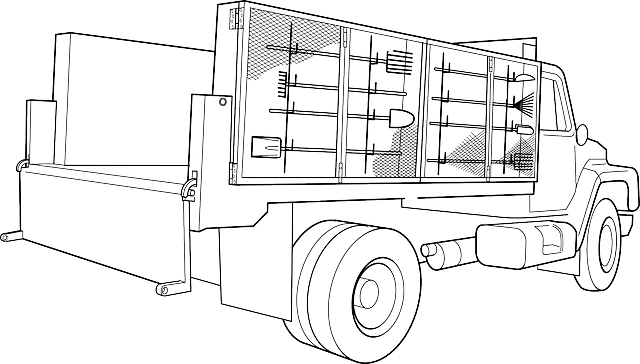Looking to register your car in California? This comprehensive guide breaks down the process, from understanding the DMV’s VIN verification to gathering essential documents. We provide a step-by-step registration process and offer tips for common issues. By following these instructions, you’ll ensure a smooth experience, avoiding delays and hassle. Key terms: DMV, VIN verification.
- Understanding the DMV VIN Verification Process
- Gathering Necessary Documents for Car Registration
- The Step-by-Step Guide to Registering Your Vehicle
- Common Issues and How to Resolve Them
- Important Tips for a Smooth Registration Experience
Understanding the DMV VIN Verification Process

When registering your car in California, understanding the DMV VIN verification process is crucial. The Department of Motor Vehicles (DMV) requires a Vehicle Identification Number (VIN) inspection to ensure the vehicle’s authenticity and history. This step involves verifying critical information like the vehicle’s make, model, year, and any previous damage or accidents. A valid VIN inspection is essential for completing your car registration successfully.
California offers both in-person and mobile vin verification options. While traditional in-person inspections are available at local DMV offices, mobile vin inspections provide a convenient alternative. This service allows you to get your vehicle checked for validity while saving time and effort, especially if your car is not drivable or you’re located far from a DMV branch.
Gathering Necessary Documents for Car Registration

Before heading to the DMV for car registration, it’s crucial to gather all necessary documents. This includes your vehicle’s Registration Application (Form DVF-1), which can be obtained online or in person from the California DMV. Additionally, you’ll need proof of insurance, a valid driver’s license, and the Certificate of Title (or Proof of Ownership) for your vehicle. The Certificate of Title is typically issued by the previous owner or the manufacturer, and it contains crucial details like the Vehicle Identification Number (VIN).
A key step in the registration process involves completing a DMV VIN verification to ensure the vehicle’s authenticity and history. This can be done online through the DMV’s website or at select license centers with a mobile VIN inspection service. A mobile VIN verifier can also come in handy, especially if you’re having difficulty obtaining documents from previous owners. By ensuring all documents are in order and completing any necessary verifications, such as a vin inspection, you’ll streamline the car registration process in California.
The Step-by-Step Guide to Registering Your Vehicle

Registering a car in California involves several straightforward steps, ensuring your vehicle is safe for road use and compliant with state regulations. Here’s a step-by-step guide to make the process hassle-free. Begin by gathering all necessary documents, including your driver’s license, proof of insurance, and vehicle registration from any previous state. Next, visit the California Department of Motor Vehicles (DMV) website to initiate the registration process online or in person. During this process, you’ll be required to undergo a DMV VIN verification, which confirms the vehicle’s identity using its unique Vehicle Identification Number (VIN). This step is crucial for ensuring the accuracy of your vehicle’s information and preventing fraud.
After completing the initial steps, schedule a mobile vin verification or use a mobile vin verifier to have your car inspected at a convenient location. This service checks the VIN against state records, confirming the vehicle’s history and condition. Once all verifications are clear, you can proceed with payment for registration fees, which vary based on your vehicle type. Finally, collect your registered license plate and vehicle registration documents, marking the successful completion of the registration process in California.
Common Issues and How to Resolve Them

Many car owners in California encounter challenges when registering their vehicles, often due to common issues that can be easily rectified. One such hurdle is failing the DMV VIN verification process, which checks the vehicle’s history and ensures it’s not stolen or has outstanding issues. This can occur due to a variety of reasons: incorrect or incomplete information provided, a previous owner overlooking important details, or even data entry errors by the DMV.
To resolve these problems, it’s essential to double-check all paperwork and ensure accuracy. Gather all necessary documents, including the title, registration, and proof of insurance. If you’ve recently purchased the car from an individual, verify that the seller has provided a clear title and completed all required forms. In case of discrepancies, consider using a mobile VIN verifier to conduct a quick and convenient vin inspection. This service enables you to quickly check the vehicle’s history and address any issues with the DMV before attempting registration again.
Important Tips for a Smooth Registration Experience

To ensure a smooth registration experience in California, there are several important tips to keep in mind. First and foremost, always perform a DMV VIN verification before proceeding with the registration process. This step is crucial as it helps prevent any potential issues or delays later on. The California Department of Motor Vehicles (DMV) offers both online and in-person VIN inspection services, making it easy to check the vehicle’s history and ensure its authenticity.
Additionally, consider using a mobile vin verification service if time is of the essence. These services send a licensed inspector to your location to perform a thorough vin inspection right away, which can be particularly convenient for busy individuals or those with limited mobility. Using a reputable mobile vin verifier also adds an extra layer of security and accuracy to the registration process, ensuring that every detail of your vehicle is properly documented and verified before final registration.
Registering your car in California is a straightforward process, but understanding the DMV’s VIN verification requirements is key. By gathering all necessary documents and following the step-by-step guide provided, you can ensure a smooth registration experience. Be prepared to address common issues and remember to follow important tips for a hassle-free transaction. With these steps, you’ll be on your way to legal and secure vehicle ownership in no time.



